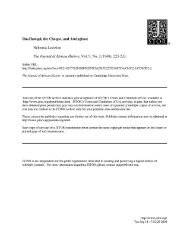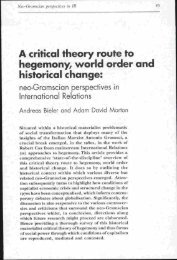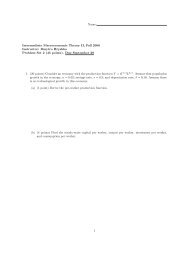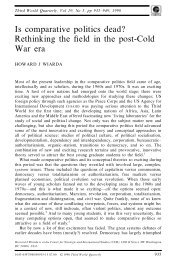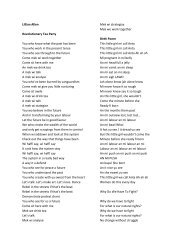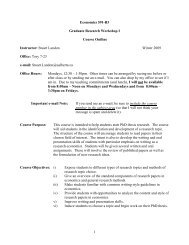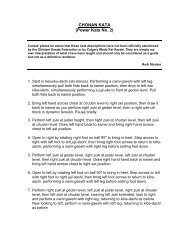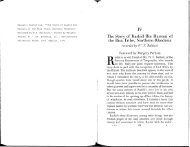2 Ethnocentric Projection and the Study of Kinship
2 Ethnocentric Projection and the Study of Kinship
2 Ethnocentric Projection and the Study of Kinship
You also want an ePaper? Increase the reach of your titles
YUMPU automatically turns print PDFs into web optimized ePapers that Google loves.
<strong>Ethnocentric</strong> <strong>Projection</strong> <strong>and</strong> <strong>the</strong> <strong>Study</strong> <strong>of</strong> <strong>Kinship</strong> … May 2008 10<br />
tennis amongst <strong>the</strong> Yanomami, or about <strong>the</strong>ir conception <strong>of</strong> tennis, would be to talk<br />
<strong>of</strong> nothing.<br />
Sleeping <strong>and</strong> breathing. Consider activities such as breathing <strong>and</strong> sleeping. Unlike <strong>the</strong><br />
above cases, in <strong>the</strong>se cases <strong>the</strong> phenomenon does occur in <strong>the</strong> particular culture<br />
under consideration, but <strong>the</strong>re is no special social or cultural significance attached to<br />
it. To view <strong>the</strong>se activities <strong>and</strong> <strong>the</strong> relations associated with <strong>the</strong>m (e.g., who is next<br />
to you when you are breathing) as providing <strong>the</strong> key to underst<strong>and</strong>ing <strong>the</strong>ir society or<br />
culture would be to fail both to underst<strong>and</strong> <strong>the</strong> world from <strong>the</strong>ir point <strong>of</strong> view <strong>and</strong> to<br />
identify something fundamental about <strong>the</strong>ir society or culture. The Vezo <strong>of</strong><br />
Madagascar brea<strong>the</strong> <strong>and</strong> sleep, like we do, but nei<strong>the</strong>r activities, nor <strong>the</strong>ir breathing<br />
or sleeping relations, play a special role in <strong>the</strong>ir society or culture, by <strong>the</strong>ir own lights<br />
or o<strong>the</strong>rwise.<br />
Illness. Like <strong>the</strong> sleeping <strong>and</strong> breathing cases, those exemplified by illness can be found<br />
in <strong>the</strong> particular society being considered, but <strong>the</strong>se social phenomena have some<br />
kind <strong>of</strong> marked significance in that society. The Nuer, like all people, get ill, <strong>and</strong> <strong>the</strong><br />
phenomenon <strong>of</strong> illness is important enough to be noticed <strong>and</strong> <strong>the</strong>orized about.<br />
None<strong>the</strong>less, Nuer ideas about illness—its causes <strong>and</strong> effects, its relationship to<br />
social practices, its signification—are sufficiently different from our own that it<br />
might be misleading to carry over our concept <strong>of</strong> illness in describing <strong>the</strong>ir views <strong>of</strong><br />
what we call “illness” or particular illnesses.<br />
The <strong>Ethnocentric</strong> <strong>Projection</strong> Thesis about <strong>Kinship</strong> has assimilated kinship to each <strong>of</strong> <strong>the</strong>se<br />
cases at various points. It is striking that Schneider’s most striking polemics (e.g., “kinship is<br />
like totemism, matriarchy, <strong>and</strong> <strong>the</strong> ‘matrilineal complex’. It is a non-subject. It exists in <strong>the</strong><br />
minds <strong>of</strong> anthropologists but not in <strong>the</strong> cultures <strong>the</strong>y study” (1972:51)), as well his three<br />
axioms <strong>of</strong> traditional kinship studies, assimilate kinship to ei<strong>the</strong>r <strong>of</strong> <strong>the</strong> first two cases: it is<br />
ei<strong>the</strong>r a mere <strong>the</strong>oretical abstraction, or a specific cultural form existing only in societies in<br />
which we are natives. Yet when focusing on aspects <strong>of</strong> kinship, such as reproduction <strong>and</strong><br />
genetic relatedness, whose biological underst<strong>and</strong>ing is central to our own conception <strong>of</strong><br />
kinship, by contrast, Schneider assimilates kinship to cases like those <strong>of</strong> sleeping <strong>and</strong><br />
breathing, where <strong>the</strong> anthropological error <strong>of</strong> projection is synecdochical in nature, giving an<br />
aspect or part <strong>of</strong> kinship a significance greater than it has for kinship elsewhere. The same<br />
kinds <strong>of</strong> shift between <strong>the</strong>se first three ways to underst<strong>and</strong> <strong>the</strong> claim that kinship doesn’t<br />
exist in a target culture pervade <strong>the</strong> post-Schneiderian literature on kinship.<br />
One irony here is that <strong>the</strong> case most closely resembling <strong>the</strong> situation <strong>of</strong> kinship is<br />
surely <strong>the</strong> fourth, exemplified by illness. There is a social phenomenon that is not directed<br />
by what I’ll call cognitive-mediation. People get sick, <strong>the</strong>y are treated, <strong>the</strong>y recover; <strong>the</strong>y<br />
reproduce, <strong>the</strong>y are born, <strong>the</strong>y are socially dependent in <strong>the</strong>ir early years. They do so whatever<br />
<strong>the</strong>ir particular conceptions <strong>of</strong> <strong>the</strong>se phenomena. Yet <strong>the</strong>re is cultural variation in just how <strong>the</strong>se<br />
phenomena are construed <strong>and</strong> <strong>the</strong> significance <strong>the</strong>y have for broader social arrangements,<br />
variation significant enough to question whe<strong>the</strong>r our conceptions are appropriate for capturing<br />
<strong>the</strong> reality <strong>of</strong> illness or kinship as it exists over <strong>the</strong>re. Can we use <strong>the</strong> terms in our kinship<br />
system (mo<strong>the</strong>r, sibling, uncle) <strong>and</strong> its systematization in kinship <strong>the</strong>ory (patrilineal,<br />
exogamous) to express adequately what kinship is in o<strong>the</strong>r cultural contexts And even<br />
supposing that this classic problem <strong>of</strong> translation or interpretation is resolved, does <strong>the</strong><br />
adoption <strong>of</strong> <strong>the</strong> kinship perspective get at <strong>the</strong> heart <strong>of</strong> how social structure is lived,<br />
experienced, <strong>and</strong> felt in those cultural contexts The <strong>Ethnocentric</strong> <strong>Projection</strong> Thesis<br />
underpins negative answers to ei<strong>the</strong>r or both <strong>of</strong> <strong>the</strong>se questions.



